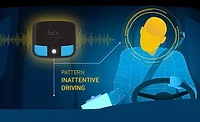Driving Behavior
Driving Behavior
David Kolman
Encountering aggressive
drivers has become a regular occurrence. Law enforcement officials define
aggressive driving as the operation of a motor vehicle in an unsafe and
hostile manner without regard to the safety of other motorists and/or
passengers. They say aggressive driving is usually the result of
frustration, impatience and irritability.
Aggressive drivers are those who run stops signs and
red lights, speed, tailgate, cut other vehicles off, pass on the wrong side
or on the shoulder of the road, drive recklessly, weave in and out of
traffic without signaling, scream, make offensive gestures and honk at
other drivers and so forth.
In extreme cases, these drivers’ aggression
turns into road rage, where a driver will deliberately try to harm another.
Such altercations on the roadway can result in collisions and personal
attacks, which put the safety of your drivers and others in jeopardy.
By being cautious and courteous, a driver can often
avoid creating a situation that may provoke another driver, advise law
enforcement and safety professionals. They offer these suggestions for
helping drivers stay safe when they encounter an aggressive driver:
Stay calm and relaxed, and do not respond in anger.
Avoid eye contact.
Steer clear and try to get out of the vicinity.
Do not challenge or confront an aggressive driver, as
this could make matters worse.
Use the horn sparingly.
Ignore inappropriate hand or facial gestures, and do not
return them.
Resist any attempts by an aggressive driver to engage you
verbally.
If you have a cell phone and can do it safely, report
aggressive driving incidents to local law enforcement. Provide them with a
vehicle description, license number, location and direction of travel.
Be sure to share these recommendations with your
drivers. BI
David Kolman is a veteran truck communicator, keynote
speaker and long-haul trucker. Commissioned as an Honorary Colonel on the
Kentucky governor’s staff for his work promoting traffic safety, he
actively participates in trade associations and reports news and
information about the trucking industry for broadcasting and print media.
Predicting truck accidents
Research by the American Transportation Research
Institute (ATRI) has identified the relationship between specific driving
behaviors with the likelihood of a vehicle accident. This early warning
system of future crash predictability allows a fleet the opportunity to
take the necessary steps to change divers’ safety and driving
behavior.
The study, Predicting Truck Crash Involvement:
Developing a Commercial Driver Behavior-Based Model and Recommended
Countermeasures, finds “reckless driving and improper turn violations
as the two violations associated with the highest increase in likelihood of
a future crash. The four convictions with the highest likelihood of a
future crash are: improper or erratic lane change; failure to yield right
of way; improper turn, and failure to maintain proper lane. When a driver
receives a conviction for one of these behaviors, the likelihood of a
future crash increases between 91 and 100 percent.”
Findings summary:
If a driver had Crash likelihood increases
Reckless Driving Violation 325%
Improper Turn Violation 105%
Improper or Erratic Lane Change Conviction 100%
Failure to Yield Right of Way Conviction 97%
Improper Turn Conviction 94%
Failure to Maintain Proper Lane Conviction 91%
Past Crash 87%
Improper Lane Change Violation 78%
Failure to Yield Right of Way Violation 70%
Driving Too Fast for Conditions Conviction 62%
The study analyzed driver-specific performance
indicators on 540,750 drivers mined from data that included violations,
driver traffic conviction information and past accident involvement
information to identify driving behaviors predictive of future crash
involvement.
Equipment news roundup
Eaton’s VORAD (Vehicle
On-board RADar) Collision Warning System with SmartCruise adaptive cruise
control is available as an option for Kenworth’s T600, T800, T2000
and W900 models. The VORAD system provides forward and side object
detection and gives audio and visual warnings. SmartCruise automatically
reduces truck speed when vehicles are within a predetermined range by
reducing fuel to the engine and engaging the engine retarder.
Hino Trucks has teamed with Fontaine Modification to
offer a single-axle Class 7 tractor version of Hino’s Model 338
straight truck. The Hino 338 City Tractor is powered by Hino’s 260-hp
J-Series engine mated to an Allison 3300 RDS automatic transmission.
Available in two wheelbases — 144 and 151 inches — the tractor
comes with a Meritor 21,000-pound capacity rear axle with Hendrickson air
suspensions, or a 23,000-pound capacity rear axle with spring suspension.
Johnson Refrigerated Truck Bodies’ new
Kegger refrigerated trailer is specifically for delivering draft beer. Its
double-drop design between the front and rear provides easy driver access
from near street level. Built with seamless fiberglass panels, the trailers
are available in lengths from 27 to 36 feet, with split or single doors on
each side. There are steel diamond plate floors and racking for empty kegs.
The largest Keggers have a payload of up to 100 half-barrel kegs. Diesel or
eutectic holdover plate refrigeration are available.
Kenworth achieved the highest ranking in customer
satisfaction among Class 8 truck owners in the Pickup and Delivery, Over
The Road and Dealer Service Segments of the J.D. Power and Associates 2005 Heavy Duty Truck Customer Satisfaction Study. Customer satisfaction for the three product segments is
measured on six factors: quality, exterior, engine, ride/handling/braking,
transmission and interior.
Mack Trucks is making Bendix’s ABS-6
Advanced with ESP — an electronic vehicle stability technology that
provides a higher level of protection against the possibility of rollovers
and jackknifes — available on its highway models. The system works by
selectively applying the brakes on individual wheel ends, depending on
driving conditions, vehicle speed and other inputs from onboard sensors, to
assist the driver in reducing speed, keeping the vehicle in proper
alignment and reducing the possibility of a slide or jackknife.
Looking for a reprint of this article?
From high-res PDFs to custom plaques, order your copy today!





